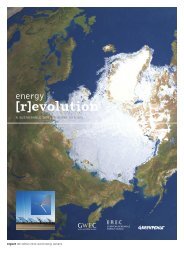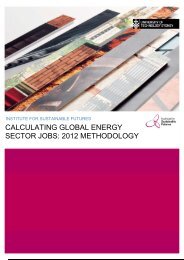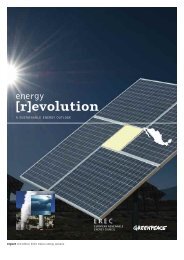download the turkey energy revolution scenario
download the turkey energy revolution scenario
download the turkey energy revolution scenario
Create successful ePaper yourself
Turn your PDF publications into a flip-book with our unique Google optimized e-Paper software.
GLOBAL ENERGY [R]EVOLUTION<br />
A SUSTAINABLE TURKEY ENERGY OUTLOOK<br />
6<br />
key results | ELECTRICITY DEMAND<br />
electricity generation<br />
The development of <strong>the</strong> electricity supply sector is characterised by<br />
a dynamically growing renewable <strong>energy</strong> market and an increasing<br />
share of renewable electricity. This will compensate for <strong>the</strong> phasing<br />
out coal and lignite power plants and reduce <strong>the</strong> number of gasfired<br />
power plants after 2030 required for grid stabilisation. By<br />
2050, 84% of <strong>the</strong> electricity produced in Turkey will come from<br />
renewable <strong>energy</strong> sources. ‘New’ renewables – mainly wind, solar<br />
<strong>the</strong>rmal power plants (CSP), modern biomass and PV – will<br />
contribute 71% of electricity generation. The following strategy<br />
paves <strong>the</strong> way for a future renewable <strong>energy</strong> supply:<br />
• The phasing out of coal power plants and rising electricity<br />
demand will be met initially by bringing into operation new highly<br />
efficient gas-fired combined-cycle power plants, plus an<br />
increasing capacity of wind turbines, concentrated solar power<br />
plants photovoltaics and biomass. In <strong>the</strong> long term, wind and<br />
solar photovoltaics will be <strong>the</strong> most important sources of<br />
electricity generation.<br />
• Solar <strong>energy</strong>, hydro and biomass will make substantial<br />
contributions to electricity generation. In particular, as nonfluctuating<br />
renewable <strong>energy</strong> sources, hydro and solar <strong>the</strong>rmal,<br />
combined with efficient heat storage, are important elements in<br />
<strong>the</strong> overall generation mix.<br />
• The installed capacity of renewable <strong>energy</strong> technologies will grow<br />
from 14 GW in 2005 to 146 GW in 2050. Increasing renewable<br />
capacity by a factor of ten within <strong>the</strong> next 40 years requires<br />
political support and well-designed policy instruments, however.<br />
There will be a considerable demand for investment in new<br />
production capacity over <strong>the</strong> next 20 years. As investment cycles<br />
in <strong>the</strong> power sector are long, decisions on restructuring <strong>the</strong><br />
world’s <strong>energy</strong> supply system need to be taken now.<br />
To achieve an economically attractive growth in renewable <strong>energy</strong><br />
sources, a balanced and timely mobilisation of all technologies is of<br />
great importance. This mobilisation depends on technical potentials,<br />
cost reduction and technological maturity. Figure 6.7 shows <strong>the</strong><br />
comparative evolution of <strong>the</strong> different renewable technologies over<br />
time. Up to 2020, hydro-power and modern biomass power plants will<br />
remain <strong>the</strong> main contributors to <strong>the</strong> growing market share. After<br />
2020, <strong>the</strong> continuing growth of wind will be complemented by<br />
electricity from geo<strong>the</strong>rmal <strong>energy</strong>, photovoltaic and solar <strong>the</strong>rmal<br />
(CSP) <strong>energy</strong>. None of <strong>the</strong>se numbers describe a maximum feasibility,<br />
but a possible balanced approach. With <strong>the</strong> right policy development,<br />
<strong>the</strong> solar industry believes that a much fur<strong>the</strong>r uptake could happen.<br />
This is particularly true for concentrated solar power (CSP) which<br />
could unfold to 6GW already by 2020 and more than 14GW in 2050.<br />
We are also aware that in <strong>the</strong> new `<strong>energy</strong> strategy paper` of <strong>the</strong><br />
government, wind <strong>energy</strong> capacity is aimed to reach 20GW by 2020.<br />
We welcome <strong>the</strong> decision if <strong>the</strong> government is committed to update<br />
massively <strong>the</strong> conditions of <strong>the</strong> grids in Turkey in <strong>the</strong> coming ten<br />
years. The <strong>energy</strong> [r]evolution <strong>scenario</strong> forsees a lower wind capacity<br />
by 2020, as a very ambitious <strong>energy</strong> efficiency startegy is included in<br />
this concept as well. A combination of new renewable power<br />
genereation and efficiency represents <strong>the</strong> most cost effective pathway<br />
for a future sustainable power supply for Turkey.<br />
figure 6.6: <strong>turkey</strong>: development of electricity generation<br />
structure under <strong>the</strong> two <strong>scenario</strong>s<br />
(‘EFFICIENCY’ = REDUCTION COMPARED TO THE REFERENCE SCENARIO)<br />
figure 6.7: <strong>turkey</strong>: growth of renewable electricity<br />
generation capacity under <strong>the</strong> <strong>energy</strong> [r]evolution <strong>scenario</strong><br />
BY INDIVIDUAL SOURCE<br />
700<br />
600<br />
500<br />
400<br />
300<br />
200<br />
100<br />
160<br />
140<br />
120<br />
100<br />
80<br />
60<br />
40<br />
20<br />
TWh/a 0<br />
REF E[R]<br />
2005<br />
REF E[R]<br />
2010<br />
REF E[R]<br />
2020<br />
REF E[R]<br />
2030<br />
REF E[R]<br />
2040<br />
REF E[R]<br />
2050<br />
GWel 0<br />
E[R]<br />
2005<br />
E[R]<br />
2010<br />
E[R]<br />
2020<br />
E[R]<br />
2030<br />
E[R]<br />
2040<br />
E[R]<br />
2050<br />
36<br />
‘EFFICIENCY’<br />
RES IMPORT<br />
OCEAN ENERGY<br />
SOLAR THERMAL<br />
• PV<br />
GEOTHERMAL<br />
WIND<br />
HYDRO<br />
BIOMASS<br />
GAS & OIL<br />
• COAL<br />
NUCLEAR



![Energy [R]evolution - European Commission](https://img.yumpu.com/49109324/1/184x260/energy-revolution-european-commission.jpg?quality=85)


![5905 gp [eu rev]csfr4.qxd - Energy [R]evolution](https://img.yumpu.com/42305023/1/184x260/5905-gp-eu-revcsfr4qxd-energy-revolution.jpg?quality=85)

![5905 gp [eu rev]csfr4.qxd - Energy [R]evolution](https://img.yumpu.com/28729264/1/184x260/5905-gp-eu-revcsfr4qxd-energy-revolution.jpg?quality=85)
